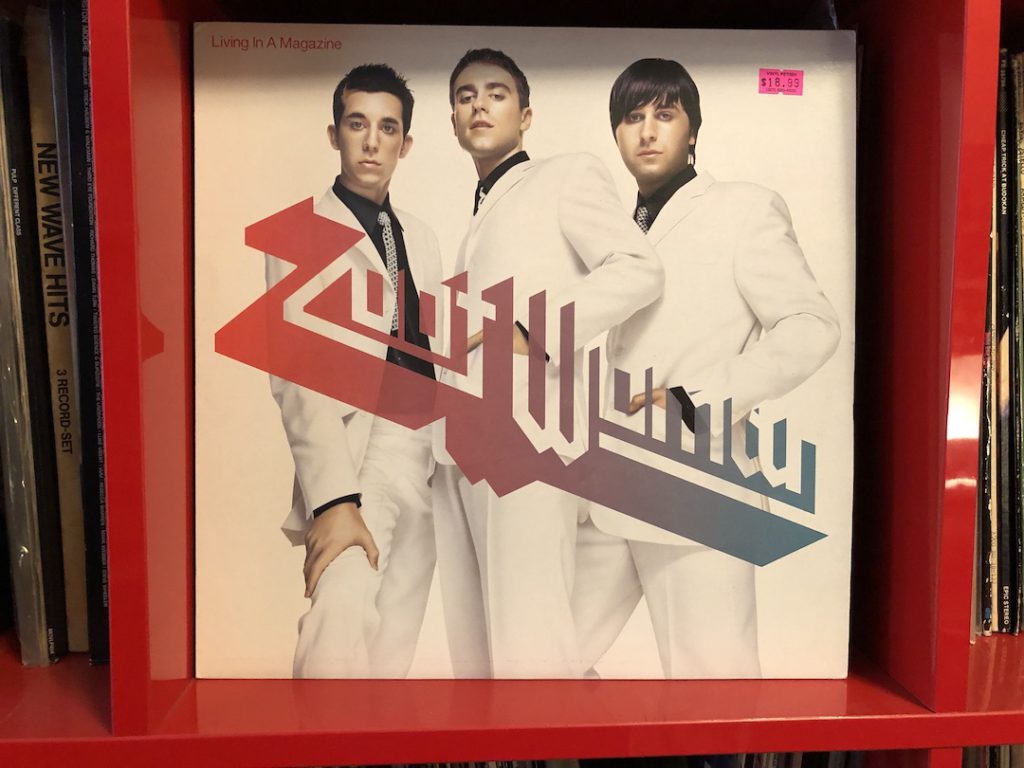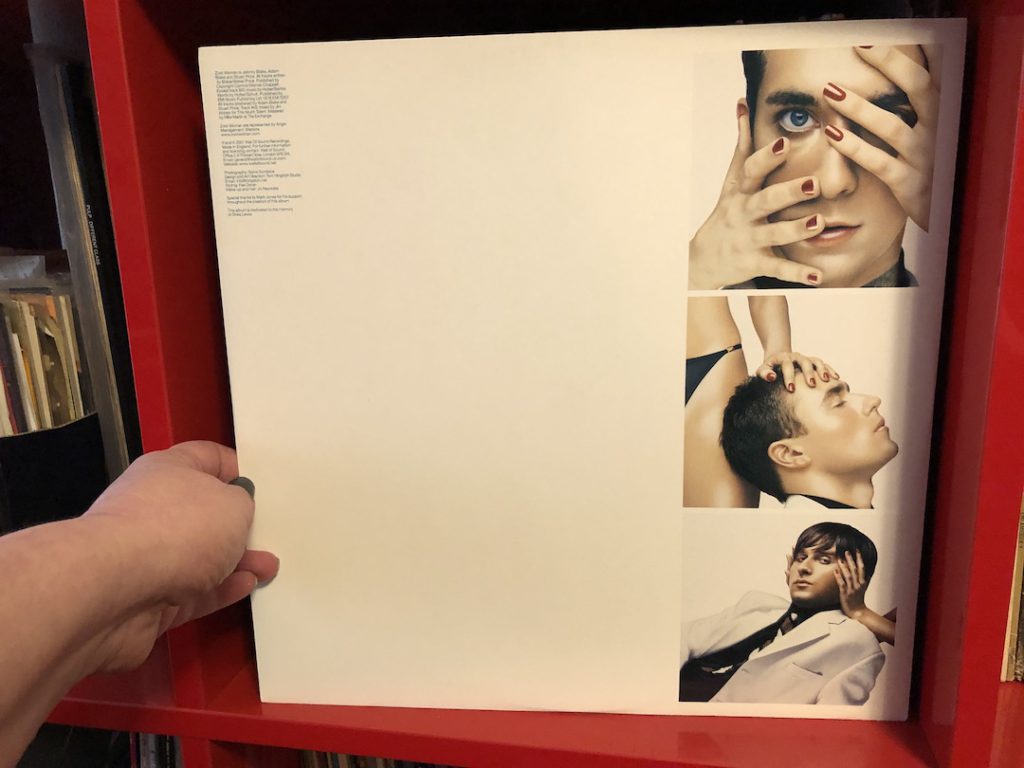
For all-vinyl gigs, I often bring my copy of Living in a Magazine, the 2001 debut full-length from Zoot Woman, with me. The reason why is simple. No matter which song I play off this album, at least one person will come up to the booth and ask about it. In fact, that happened last Friday night, when I played the band’s cover of “The Model” at Club Synth. More than 20 years later, this album is still a vibe.
Living in a Magazine is one of my favorite records of the early ‘00s. In fact, I would argue that it’s one of the finest, and certainly most under-appreciated, albums of the era. The brand of soft funk-meets-indie disco that Zoot Woman cultivated on this album helped solidify a sound that persists this day, whether or not the bands who land Spotify playlists like Pollen and Indie Chillout realize it. At the turn of the 21st century, few outside of Zoot Woman and Phoenix were riding such a mellow groove. This was a handful of years before bands like Hot Chip and Holy Ghost hit the scene, before the fascination with “yacht rock” and definitely before the vinyl resurgence sent a new generation of crate diggers on the hunt for the smoothest sounds of the 1970s and 1980s.
It’s wild to me that Living in a Magazine isn’t as well-known as it should be. In a way I get it. At the time of its initial release, the album was really tough to find in the U.S. Now, you can listen to it on Spotify, so it’s not exactly obscure. Plus, Zoot Woman is still an active group, with multiple albums to their credit and new music. Moreover, bassist Stuart Price became Grammy-winning producer and remixer. But even his name isn’t household one, unless your household, like mine, believes that Confessions on a Dance Floor is Madonna’s greatest album and Aphrodite is *still* Kylie Minogue’s best work.
In the very little press that I’ve been able to dig up online, Zoot Woman was pegged as ‘80s revival and/or electroclash and none of those tags are particularly accurate. The white suits the trio wore on the cover of Living in a Magazine were a little Duran Duran-ish, but that’s about the extent of it. Really, and I think this is what I really loved about this album, Living in a Magazine was the rock equivalent of French house. There are threads to the past that point to lots of different possible influences. Obviously, Kraftwerk is one, given that there’s a cover of “The Model” on the album. But, also, there’s hints of Can and Steely Dan in there as well. Despite all that, like Daft Punk, Cassius, et. al., it’s an album that sounded more like the era in which it was made than a flashback to the past.
All of this reminds me that, particularly when it comes to the earliest years of the ‘00s, there are a lot of collective memory gaps. I suspect this has a bit to do with the transition from old to new media. The internet isn’t as great of an archive as people thought it would be and documentation of bands, even whole music scenes, have fallen through the cracks.
Plus, the way we engage with history today doesn’t account for how slowly culture once traveled, even at a time when the internet was in fairly wide use. Take Living in a Magazine as an example. The album came out in 2001 on a British indie label called Wall of Sound. I probably first heard the name Zoot Woman in a music forum, because there were loads of Europeans in those spaces. It’s also likely that I heard Stuart Price was the bassist. That’s something I would have noted because I was fan of his project Les Rythmes Digitales.
However, listening to music online at that point was a real pain in the ass and radio was already almost completely useless. So, even if I first heard of Zoot Woman in a forum, I would have first heard their music in a DJ mix released on CD. Most likely, that was Electroclash: Massive 19 Track Mix From Miss Kittin, which came with an issue of Muzik Magazine in 2002 and was played on repeat in my car for months. Then I had to find the album, which took a good while. In fact, I was already playing a remix 12” of Zoot Woman’s single “It’s Automatic” regularly in my club sets (and still have the BPM note in the sleeve to prove it) before I finally found an import copy of Living in a Magazine at Vinyl Fetish.
By the time I owned a copy of the album, Living in a Magazine had been out for at least a year, maybe closer to two years. That delay, though, didn’t really matter because this was a decade before the viral-or-nothing era. You didn’t have to buy a record as soon as it came out because it was more-or-less normal for music (and movies and books) to gain popularity over time. In the case of music, it could take a few years for songs to become club hits and then they stuck around for long time after that. For example, some of the hits associated with the ‘00s— I-F “Space Invaders Are Smoking Grass,” Zombie Nation “Kernkraft 400” and Miss Kittin & the Hacker “Frank Sinatra,” to name a few— were actually released at the end of the 1990s. The new music that was immediately popular typically came from bands everybody already knew, bands who had already gone through the slow climb superstar status. That’s just how culture works when it’s not dictated by social media platforms.

Living in a Magazine is a dance music made with the instruments that, by the turn of the 21st century, were deemed rock. (A truly baffling mentality considering how much disco was made with guitar, bass and drums. Also, rock ’n’ roll was the dance music of its time.) The rhythm section is not buried in the mix, so the beat keeps heads bopping and toes tapping, while the bass dictates how the rest of your body will move. And, you will move, even on the mellower cuts, like “It’s Automatic,” “Jessie” and “Chicago, Detroit, L.A.” The lyrics are fairly easy to memorize, which is always good for a dance song. On the title track, they pull the old pop hit trick of pairing an upbeat song with fairly dark lyrics. It’s all rooted in classic pop music, but, the vibe of the album was probably five years ahead of its time.
There are loads of albums like this out in the world. Some are, eventually, rediscovered. Some aren’t. Even after the so-called democratization of music, the best albums don’t rise to the top upon their release. The ones with the best promotion teams and biggest budgets do. But, the upside for the albums that get somewhat lost in time is that there’s always someone who will hear it for the first time. I keep Living in a Magazine in my crates for that reason.
Liz O. is an L.A.-based writer and DJ. Read her recently published work and check out her upcoming gigs.
Related:
HERE’S WHAT I PLAYED AT CLUB SYNTH ON FRIDAY, FEBRUARY 23, 2024
“ME AND MY MUSIC”: THE CANDI STATON SONG THAT REMINDS ME WHY I DJ
THE TIME CHAZ JANKEL’S POST-DISCO JAM “AI NO CORRIDA” TURNED UP AT FINGERPRINTS
